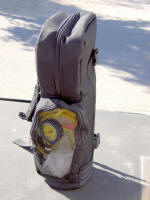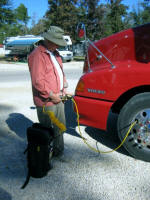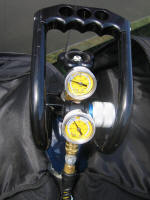
Please wait, I'm coming over...

Last Changed 10/24/2009 |
|||
click on images to enlarge |
|||
|
Low tire pressure is one of the most dangerous things an RV can
experience. When tires have low pressure, the tires run hotter and
the internal cord structure starts to break down. But maintaining
the correct tire pressure on an RV can be more difficult than it
appears. RVs are more sensitive to tire pressure than cars. RVs tend to have tire capacity that matches the full weight of the RV and we tend to fill the RVs to full weight. For example, Tige has six "G" rated tires which at full air pressure (110 psi) have a rating of 3750 lbs. each, making a total tire weight capacity of 22,500 lbs. Tige weighs in at 22,000 lbs. with full tanks. If the tire pressure drops to 100 psi, each tire loses 200 lbs. of capacity for a net loss of 1200 lbs., Tige would be overweight for the under inflated tires. You can see that RV tire pressure is critical.
The tires on Tige need to be filled to 110 psi. The front tires on Red Rover need to be 105 psi. These kind of air pressures are not easily generated outside of a truck service plaza. We prefer not to use a truck service plaza. We like to check wheel lug nut torque and tire air pressure in the RV park, where we can do it at our leisure. And the tires are cold (not moved), which is how tire pressure should be set. There is an air compressor on Red Rover that feeds the several air systems. The most important system is the air brake system. The compressor is designed to cut in around 100 psi and cut out at 120 psi. We tapped one of the air tanks and connected an air chuck to use for sundry tasks. To fill a 110 psi tire requires at least 120 psi. Red Rover's air tank has only have 120 psi for a short period when being used to inflate a tire. The air compressor does not turn on until the air pressure drops to 100 psi. So if you do not get a tire filled before the tank pressure drops too low, you have to bleed off the tank pressure until the compressor turns on. When the compressor turns off, meaning that 120 psi has been reached, then you can try to top the tire off again. This is very inconvenient. The rear tires of Red Rover only need 85-90 psi and the truck compressor can handle that. We had a “250 psi” 12 volt compressor when we had our motorhome, and that compressor was ineffective in topping off the motorhome tires at 90 psi. We were still in our house when we had our motorhome and we acquired a high powered AC compressor to use on the motorhome tires. We do not have the space for a high capacity AC air compressor in our rig. |
|||
 |
We found a solution...the Power Tank system. The Power Tank is a very
high pressure tank filled with CO2 gas. The tank has a regulator
that controls the pressure that can be fed to the tires. The Silver
package includes the regulator, hose, chuck, and a canvas carrying
bag for the tank and accessories. The tank can be used for numerous
tire topping off fills (40+) before refilling is necessary. Refills
can be done at a gas supplier like a welding supply house. <update> Since we have had the Power Tank, we have been refilling about once a year. |
||
click on images to enlarge |
|||
Our Pressure Pro System tells us when we need to top off the tires. It gives us the pressure in each tire on Red Rover and Tige without having to use a tire inflator. When we need to top a tire off, we can carry the tank to the wheels and top them off. With this system, we avoid emergency tire situations...a flat tire or, even worse, a blowout while we are traveling. |
|||
 |
We opted to get the Gold package because it included a very accurate
gauge inflator. The inflator we had at the time was off by 5-10
psi.
We found it inconvenient to fill tires with the inaccurate inflator,
guessing the pressure, and then checking with our digital pressure
gauge. There are other accessories in the Gold package, including a 6' extender and two double foot chucks. |
||
 |
Here is the Power Tank as you would normally use it. You don't have
to take the tank out of the bag. The fittings used on the Power Tank are of excellent quality. We have never had air fittings that worked so smoothly and yet snap together so positively, There are quick disconnects on the tank regulator, each hose, the inflator, and the chucks. |
||
click on images to enlarge |
|||
 |
The bag that is part of the Platinum, Gold, and Silver Packages hold the tank and all the accessories, We were surprised at the quality of the bag. There is a handle on the top and the side of the bag. | ||
 |
Here Mark is making use of the 6' extension that connects to the
inflator. This extender allows you to stand away from the tire as
you fill it. There is a coiled hose from the tank to the inflator.
The gauge on the inflator is large and easy to read. The snap-on
chuck used here clicks positively on to the valve stem. The regulated CO2 output is 160 psi and the time to top off the tire is seconds for each. With one of those "250 psi compressors", we would have spent hours. |
||
click on images to enlarge |
|||
 |
We acquired this accessory for our Power Tank System. This is the
new HPX Regulator that has an adjustable output pressure for use
with power tools that usually don't need as much pressure as used
with tire inflation. |
||
 |
There are two gauges. The top gauge reads the total tank pressure. The lower gauge displays the pressure setting you set for inflation or tool usage. |
||
click on images to enlarge |
|||
 |
We got a new addition to our Power Tank, a Digital Gauge. This
gauge is available from Power Tank as a replacement or as an
addition with new systems. We
tested it and it was 4 psi more accurate that the old analog gauge. To be fair, the old gauge had gotten loose inside and my repair probably offset the calibration. The digital display automatically turns on when you read air pressure. There is a backlight that can be turned on and the batteries are standard AAA. |
||
Disclaimer: The information in this site is a collection of data we derived from the vendors and from our personal experiences. This information is meant as a learning guide for you to make your own decisions Best practices and code should always be followed. The recommendations we make are from our personal experiences and we do not receive any compensation for those recommendations. |